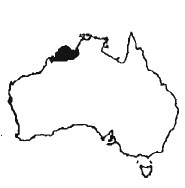Varanus Glauerti
 |
Glauert's goanna
Glauert's goanna is an elegant, rock-dwelling lizard with a very long tail and long limbs. Mertens described it from two specimens previously assigned to V.timorensis similis. This beautiful goanna is found only in the extreme north of Western Australia and the Northern Territory, and also occurs on a number of islands off the coast (Storr 1980; Rankin et al 1987; Rokylle 1989). Rankin et al (1987) note that they are found in the highest parts of Amhemland. Western specimens often have an ocellated pattern on the back, whilst those from further east have a barred pattern. Those from the south parts of the range in Western Australia tend to have more yellow colouration than those from the north. Hatchlings are said to be extraordinarily beautiful animals with very bright blue colouration (Green & King 1993). They reach a total length of about 80cm of which only about 30cm is head and body. The tail varies between 183-268% of the SVL. Average SVL of 31 specimens examined by James et at (1992) was 19.8cm. A captive specimen at least seven years old weighed 165g (Hodge pers.comm.).
Glauert's goanna inhabits dry rocky areas and has been seen foraging in leaf litter amongst boulders (Rankin et al 1987). Rokylle (1989) saw them foraging on vertical rock faces. in ground vegetation and on trees and reports that wild specimens accustomed to humanity will even forage on people if they remain still. Losos & Greene found that orthopterans and spiders were the major prey. along with roaches. caterpillars, lizards and their eggs. James et al( 1992) considered that lizards (geckoes and skinks), orthopterans and spiders were their major foods . Virtually nothing is known of the reproductive biology of this species; James et al (1992) suggest th at eggs are laid at the end of the dry season and beginning of the rainy season (November to January). Clutch size and length at sexual maturity are unknown but they rel:orcied a female of 165mm SVL which contained three eggs.
I can find no records of this species reproducing in captivity. Males can be distinguished by the. presence of enlarged and raised (but not spiny) scales on either side of the tail base. In captivity the species likes to burrow and can be kept with agamids and skinks of a similar size. Insects small mammals and other lizards are probably suitable foods. They show a liking for tomato in captivity.
Attribution / Courtesy: Daniel Bennett. 1995. A Little Book of Monitor Lizards. Viper Press U.K.




